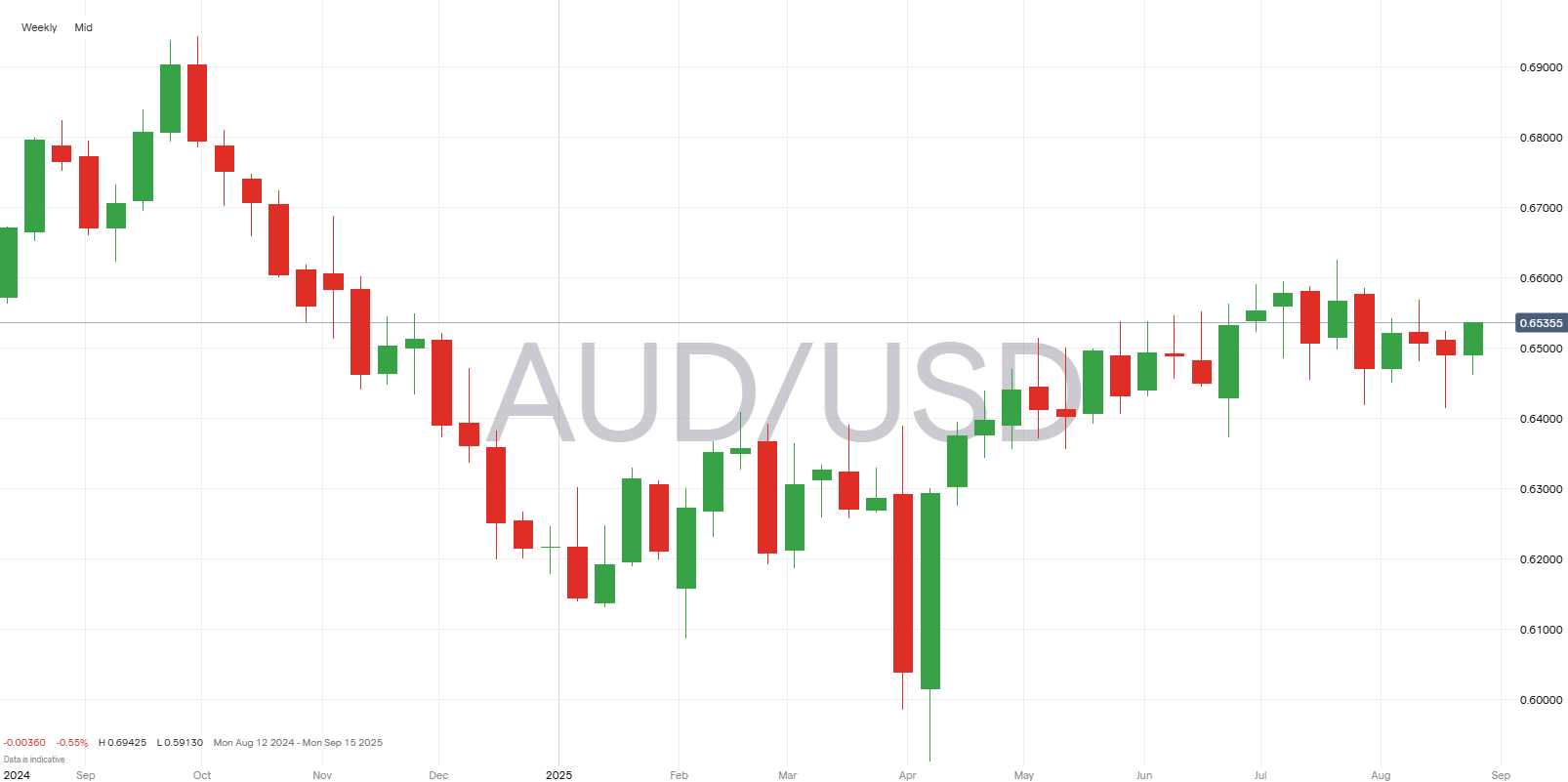Strength in the Aussie Dollar Looks Fleeting Without a China Comeback
Powell lit the spark, but China holds the matchbook for the Aussie dollar’s near-term outlook.

Key points
- The Australian dollar bounced back above 0.6500 against the US dollar after Powell’s Jackson Hole pivot, underscoring how Fed policy shifts ripple through global currency markets.
- China’s economy remains the key drag, with deflation and slowing output weighing on demand for Australian commodities and limiting AUD’s upside.
- Without a broader trade breakthrough or stronger Chinese recovery, sideways or neutral positioning may prove more rewarding than outright bullish bets on the Aussie.

Currency markets got a modest jolt from Jerome Powell’s speech at Jackson Hole. After months of signaling patience, the Fed chair suggested the central bank may be open to cutting rates sooner than expected. That subtle shift rattled the U.S. dollar—the dollar index (DXY) dipped in response—and sent ripples across global FX markets.
The euro, already on an upswing against the greenback throughout 2025, extended its gains. Yet the more dramatic reaction came from the Australian dollar. After a late 2024 skid against the USD and a tariff shock to the downside in April, the Aussie has been fairly rangebound through much of 2025—trading between 0.6400 and 0.6600 in the last 4 months. Powell’s dovish tone triggered a swift rebound, pushing the AUD back above 0.6500.
Beyond the AUD’s own move, this moment underscored the Fed’s outsized influence across global financial markets. A mere shift in tone from Powell was enough to recalibrate yield expectations, depress U.S. rates, and drive broad-based moves—not just in FX, but in equities and commodities. This episode is a stark reminder of how global capital flows remain tightly tethered to U.S. monetary policy—and why traders from Sydney to Frankfurt hang on every signal from Washington.
Commodities, China, and the Aussie Dollar’s Near-Term Outlook
If the Jackson Hole bounce showed how quickly Fed policy can move the Aussie dollar, the broader outlook still hinges on something closer to home: commodities and China. Australia remains heavily dependent on resource exports—iron ore, coal, natural gas—and China is by far its largest trading partner. That makes the AUD unusually sensitive to swings in Chinese demand and the broader commodity cycle.
Right now, the signals from China aren’t encouraging. Deflationary pressures are mounting, with producer prices falling 3.6% year-over-year in July and consumer prices barely registering growth. Industrial output slowed to just 5.7% in the same month, the weakest pace since late 2024, while retail sales expanded only 3.7%. Together, these data points paint a picture of an economy struggling under the weight of a prolonged housing slump, sluggish investment, and fragile domestic demand.
For Australia, the risk is straightforward. A softer Chinese economy means reduced appetite for raw materials, weaker export volumes, and pressure on Australia’s trade balance. That dynamic has already pressured the AUD/USD through much of 2025, contributing to its slide from 0.6600 to near 0.6400. The rebound to 0.6500 after Powell’s Jackson Hole speech may prove short-lived if China’s slowdown deepens, pulling down commodity demand in the process.
The AUD is more than a read on rate spreads; it’s a gauge of global growth—with China at the pivot. Until Beijing revives momentum, Australia’s currency will track those fortunes, making durable rallies hard to sustain.
Trading Takeaways
The Aussie dollar’s rebound after Powell’s Jackson Hole speech highlighted just how sensitive FX markets remain to shifts in Fed policy. But while the move back toward 0.6600 was notable, the bigger picture looks less supportive. With China still mired in deflation, industrial output slowing, and domestic demand weak, Australia’s export engine lacks the momentum needed to sustain a stronger currency.
A comprehensive U.S.–China trade breakthrough could provide the real spark, boosting commodity demand and restoring confidence in Australia’s growth story. Yet even in that scenario, the U.S. dollar would likely attract fresh inflows of its own, blunting the relative upside for the Aussie.
That leaves AUD/USD in a tricky middle ground—strong enough to rally on dollar softness, but not compelling enough to justify a long-term bull case. For traders, that opens the door to more creative positioning. Rather than betting on further appreciation, strategies that lean on sideways price action may offer better risk-adjusted returns.
In practice, that might translate to contrarian strategies to take advantage of the Aussie’s tendency to churn in ranges when neither Fed policy, nor Chinese demand delivers a decisive push.
In short, AUD/USD looks more like a candidate for rangebound plays than a straightforward long or short. Until fresh catalysts emerge, sideways may be the path of least resistance—and the setup to watch.
